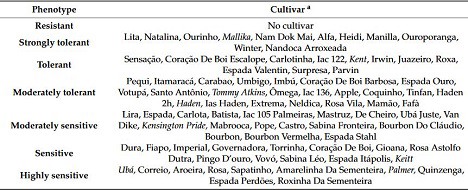Scientists at University of Catania (Italy) with Universidade Federal de Viçosa (Brazil) have conducted a wide-ranging survey in one of the most important mango cultivating areas located in Minas Gerais State (Brazil) to determine the causal agent of severe anthracnose leaf infections and to evaluate disease susceptibility within a global collection of mango germplasm. Overall, 86 cultivars were monitored and 152 fungal isolates from infected samples were identified by morphological characterization, DNA sequencing and phylogenetic analyses.
"All isolates were identified as Colletotrichum asianum. Under natural disease pressure, it has been possible to evaluate a variable tolerance degree within the germplasm collection, the scientists explained. According to the tolerance degree, cultivars were classified in 10 highly sensitive (11.6%), 13 sensitive (15.1%), 18 moderately sensitive (20.9%), 23 moderately tolerant (26.7%), 11 tolerant (12.8%), and 11 highly tolerant (10.4%). The most susceptible cultivars to anthracnose were Ubà, Quinzenga, Amarelinha da Sementeira followed by Aroeira and Correjo, whereas Mallika followed by Ourinho and Lita resulted in the least susceptible cultivars".
Mango cultivars grouped for susceptibility phenotype to anthracnose infections and relative disease incidence (DI) and severity (SS).
The authors concluded that this was the first large-scale evaluation of mango susceptibility to C. asianum infections within a wide number of cultivars. Anthracnose is a serious threat to mango production and assessments of cultivar response to disease could be useful in breeding programs. Although host resistance alone is not definitive, it can be considered a sustainable mean, since pathologists and breeders can use it both to implement IPM strategies for mango anthracnose caused by C. asianum and to reduce number fungicide treatments.
Source: Alessandro Vitale, Acelino Couto Alfenas, Dalmo Lopes de Siqueira, Donato Magistà, Giancarlo Perrone, Giancarlo Polizzi, 'Cultivar Resistance against Colletotrichum asianum in the World Collection of Mango Germplasm in Southeastern Brazil', 2020, Plants, 9, 182.
